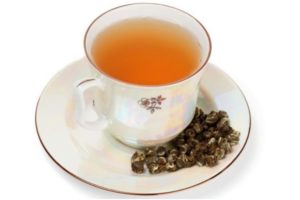The Properties of Oolong Tea: Dietary and Health Benefits
China is the original home of tea, so it is only natural that different types of tea are an important part of Chinese culture. The difference between the teas usually lies in the way they are grown and processed. This difference in production and processing methods can result in the development of characteristics and properties that are unique to each tea.
This report will take a detailed look at the dietary and health benefits that are pertinent to Oolong tea. It will also consider taking Oolong tea with other types of teas in an effort to maximize the potential dietary and health benefits that can come from synergy.
Introduction to Oolong Tea
Oolong tea is one of the lesser known teas that originated in China centuries ago and to this day is traditionally known for its rich taste and beneficial properties. Oolong tea, like green tea, black tea, white tea and Pu-erh tea is made from the tea plant (botanical name – Camellia Sinensis), which is native to China. This tea differs from other types of tea in the way it is made.
The tea is made through a unique process which includes withering the leaves under the strong sun and oxidation before curling and twisting. Within this method there are different ways in which the tea is produced, and depending on the process used, the degree of oxidation in the tea can vary – ranging from 8 to 85%.
Oolong tea is known not only for its effects on health, but also for its varied and rich taste, which can vary from sweet and aromatic with notes of honey, woody and thick, or fresh and light, depending on where and how it is produced.
The most well known oolong tea comes from the Wuyi Rock (cliff) region in Fujian province in Southeast China, but Oolong tea is also produced elsewhere in China as well as the world, including in Taiwan and India.
Oolong tea can be taken on its own or can be combined with other teas (e.g. green tea, black tea) to combine the effects of all these teas together. This is known as synergy and is the ultimate way to maximize the benefits driving from these natural teas.
The Known Health Benefits of Oolong Tea
Although lesser known especially in the west, Oolong tea is known to have several health benefits, just as green tea is. As more and more of its health benefits, especially in the area of weight loss come to light and are backed by scientific evidence, the tea is becoming increasingly popular around the world.
Oolong tea has been traditionally consumed as an overall tonic, and is thought to promote a long and healthy life. It is also thought to improve circulation and keep the body as well as mind fit and agile, by boosting metabolism, which helps burn off excess fat.
Oolong tea is known for its effects on cardiovascular health. It is rich in naturally occurring plant based anti-oxidants, which help improve circulation by keeping arteries healthy and preventing the build-up of plaque which can cause the blood vessels to narrow and harden.
This action of Oolong tea and other teas like green tea in keeping blood vessels healthy can help improve the circulation system and prevent heart disease as well as other cardiovascular problems such as stroke.
- Oolong is also traditionally known for preventing tooth decay and helping keep teeth healthy. Modern scientific research into Oolong tea finds that it contains fluoride, which is well known for being useful in keeping teeth and gums healthy.
- Oolong is also known for its calming properties. Findings from a Japanese scientific study on mice, conducted by the Institute for Health Care Science, Suntory Ltd, Mishima-gun, Osaka, suggested that Oolong tea consumption can have significant stress relieving effects.
Oolong has numerous other traditionally known properties. For instance it is known to have anti-ageing effects, being good for skin health and curing skin disorders. It is also traditionally used to control blood sugar as a treatment for diabetes.
How Might Oolong Tea aid with Weight Loss?

KouTea™ contains Green Tea, Oolong Tea, Pu-erh Tea and White Tea
One of the most significant health benefits of oolong tea is its ability to aid with weight loss and prevent excess fat accumulation.
Oolong tea contains high amounts of polyphenols, which are naturally occurring plant based anti-oxidants. These organic compounds have properties that help in increasing the rate of metabolism in the body, which helps burn fat more quickly.
Thermogenesis is the process of heat production in the body. Like green tea, and some other types of tea, Oolong tea is a thermogenic substance which stimulates metabolism and causes increased fat oxidation.
As a result of encouraging evidence gathered by studies around the world, Oolong tea is increasingly being recognized as a promoter of weight loss. The same is true for green tea and other teas like Pu-erh tea. Regular consumption of Oolong tea, in combination with other teas, can help improve circulation, boost metabolism and prevent the build-up of excessive fat in the body.
Research Findings on the Effects of Oolong Tea
As mentioned earlier, Oolong tea is rich in plant based anti-oxidants known as polyphenols. Epigallocatechin gallate is one of the main polyphenols that are found in oolong as well as green tea.
- A placebo controlled study published in the Journal of the American College of Nutrition observed six overweight men who took epigallocatechin gallate supplements for two days. The researchers found that epigallocatechin gallate has strong potential to reduce body weight by increasing fat oxidation significantly. Although the sample size of the study was small, this finding has strong implications for the role of Oolong and other teas in weight loss.
- A study conducted at the Beltsville Human Nutrition Research Center, in Maryland, USA, observed participants who drank either 4 cups of Oolong tea or 4 cups of plain water daily for three days. At the end of the observational period, it was found that the participants who drank the Oolong tea had a 3% greater energy expenditure and burned, on average, 67 more calories a day than they previously had. Apart from the higher rate of energy expenditure, Oolong tea drinkers had a whopping 12% higher fat oxidation rate than the water drinkers.
- In a 2003 study conducted in Taiwan on 1210 subjects, it was found that test subjects who had regularly consumed tea for more than ten years had a smaller waist circumference and waist to hip ratio, and lower percentage of body fat. Out of these subjects, only 4% consumed regular black tea, and 96% consumed either green or oolong tea.
- In two randomized, controlled Japanese studies, the effects of Oolong tea consumption on the metabolism of subjects were studied. Energy expenditure and rate of fat oxidation was measured in subject consuming the tea supplement. The first study found an increase in energy expenditure by 2.9% and increase in fat oxidation by 12%. The second study found an increase in energy expenditure by 4% and increase in fat oxidation by 35%.
- In a 2000 study conducted in Taiwan, the effect of black tea, Oolong tea and green tea extracts on fat absorption in rats fed with a high sugar diet were observed. The findings suggested that rats consuming Oolong tea had a reduced food intake. Cholesterol levels were lowered, and the tea consumption also showed lowering of triglyceride content in the liver.
Using Tea in Synergy
Many studies have been undertaken on other related teas, mainly green tea, as it is better known at the moment. It has been found that Oolong tea, green tea, pu-erh tea and white tea are all rich in polyphenols, being produced from the same source. All the teas have been found to have some effect on weight loss.
However, each tea has its own production and processing methods, and therefore develops its own unique properties. It therefore follows that in order to get the most from these beneficial teas, and to maximize their effect on weight loss, it may be more useful to take them in the right combinations with each other, so that they can work in synergy.
Side Effects of Oolong Tea
Oolong tea is a plant based product and has been consumed traditionally in China and other countries in the region for centuries. All the active compounds in Oolong tea that have a positive impact on health are naturally occurring and can be consumed safely.
There are no known side effects in consuming Oolong tea, either as a brew or its extract, in moderation or as prescribed. However, Oolong tea does contain caffeine and appropriate caution should therefore be exercised in consuming it.
Oolong tea, like green tea, contains high proportions of anti-oxidants, and evidence does suggest that polyphenols taken in very high concentrations could cause liver poisoning and oxidative stress. It is therefore important to be cautious and consult a doctor before taking any commercial herbal products containing Oolong tea extract, not least during pregnancy.
Summary
Oolong tea is relatively less known in the west as compared to its near cousin green tea. However, this situation is fast changing as more and more of its plentiful benefits come to light and are increasingly backed by scientific evidence.
The tea is rich in naturally occurring plant based anti-oxidants known as polyphenols, which have a host of benefits for health, especially in weight loss. Research studies have shown that these anti-oxidants help keep arteries healthy and improve circulation.
Findings suggest that Oolong tea is good for cardiovascular health, and may help in preventing heart disease and stroke. Anti-oxidants present in Oolong tea may also have anti-ageing properties, and help keep the body as well as mind youthful and active.
Oolong tea contains small amounts of fluoride, and is therefore especially good for maintaining healthy teeth and gums and preventing tooth decay.
Like green tea, white tea, and pu-erh tea, findings from various studies have suggested a strong link between Oolong tea and increased weight loss. Oolong tea activates thermogenesis, which increases the rate of fat oxidation. Studies have found that polyphenols can contribute as much as 4% of day time thermogenesis which translates to 35-43% overall fat oxidation in the body.
There is increased interest in the roles that green tea, pu-erh tea, white tea and Oolong tea play in effective weight loss. While all these teas contain certain compounds that have a significant impact on fat oxidation, each tea also has unique properties. It may therefore be useful to consume Oolong tea in combination with other beneficial varieties of tea, as this can have maximum impact on fat oxidation and help lose weight more effectively. This is what is known as the concept of synergy.
Copywrite
This is an open access article distributed under the Creative Commons Attribution License, which permits unrestricted use, distribution, and reproduction in any medium, provided the original work is properly cited.
References & External links
- Han, L. K., et al. “Anti-obesity action of oolong tea.” International Journal Of Obesity & Related Metabolic Disorders 23.1 (1999). “Oolong tea prevented the obesity and fatty liver induced by a high-fat diet.“
- Nakai, Masaaki, et al. “Inhibitory effects of oolong tea polyphenols on pancreatic lipase in vitro.” Journal of Agricultural and Food Chemistry 53.11 (2005): 4593-4598. “Fifty-four polyphenols isolated from tea leaves were evaluated for their inhibitory activities against pancreatic lipase, the key enzyme of lipid absorption in the gut. (−)-Epigallocatechin 3-O-gallate (EGCG), which is one of major polyphenols in green tea, showed lipase inhibition with an IC50 of 0.349 μM.“
- Hosoda, Kazuaki, et al. “Antihyperglycemic effect of oolong tea in type 2 diabetes.” Diabetes Care 26.6 (2003): 1714-1718. “Oolong tea may be an effective adjunct to oral hypoglycemic agents in the treatment of type 2 diabetes.“
- Zhu, Qin Yan, et al. “Antioxidative activities of oolong tea.” Journal of Agricultural and Food Chemistry 50.23 (2002): 6929-6934. “The present results support the concept that oolong tea contains several low molecular weight antioxidants that may have health promotion activities.“
- Sano, Mitsuaki, et al. “Novel antiallergic catechin derivatives isolated from oolong tea.” Journal of agricultural and food chemistry 47.5 (1999): 1906-1910. “… These inhibitory effects exceeded that of the major tea catechin, (−)-epigallocatechin 3-O-gallate, which has known antiallergic properties.“
- Rumpler, William, et al. “Oolong tea increases metabolic rate and fat oxidation in men.” The Journal of nutrition 131.11 (2001): 2848-2852. “According to traditional Chinese belief, oolong tea is effective in the control of body weight. Few controlled studies, however, have been conducted to measure the impact of tea on energy expenditure (EE) of humans.“
- 大森敬之, et al. “Antiallergic constituents from oolong tea stem.” Biological and Pharmaceutical Bulletin 18.5 (1995): 683-686. “The antiallergic constituents of oolong tea stem were examined. … These results suggest that GCG may be a novel antiallergic constituent among tea catechins, and also the most potent.“
- Komatsu, Tatsushi, et al. “Oolong tea increases energy metabolism in Japanese females.” Journal of Medical Investigation 50.3/4 (2003): 170-175. “These results suggest that oolong tea increases EE (energy expenditure) by its polymerized polyphenols.“
- Zuo, Yuegang, Hao Chen, and Yiwei Deng. “Simultaneous determination of catechins, caffeine and gallic acids in green, Oolong, black and pu-erh teas using HPLC with a photodiode array detector.” Talanta 57.2 (2002): 307-316. “The analytical results obtained indicated that green teas contain higher content of catechins [(−)-epigallocatechin gallate, (−)-epigallocatechin, (−)-epicatechin gallate, and (−)-epicatechin] than both Oolong, pu-erh and black teas because fermentation process during the tea manufacturing reduced the levels of catechins significantly. The fermentation process also remarkably elevated the levels of gallic acid in full-fermented pu-erh and black teas. Another interesting finding is the low level of caffeine in Oolong teas, especially in Fujian Oolong tea.“






